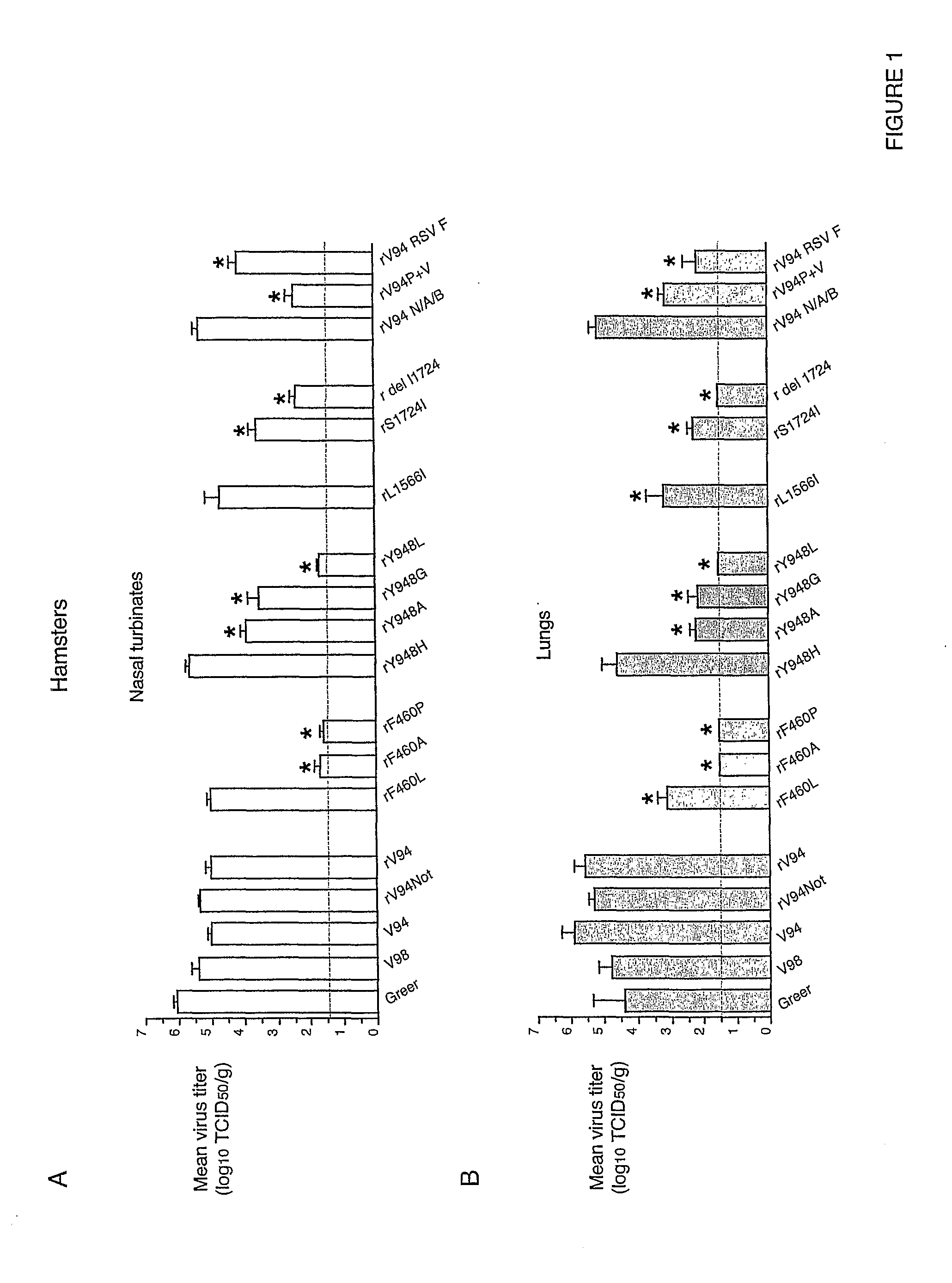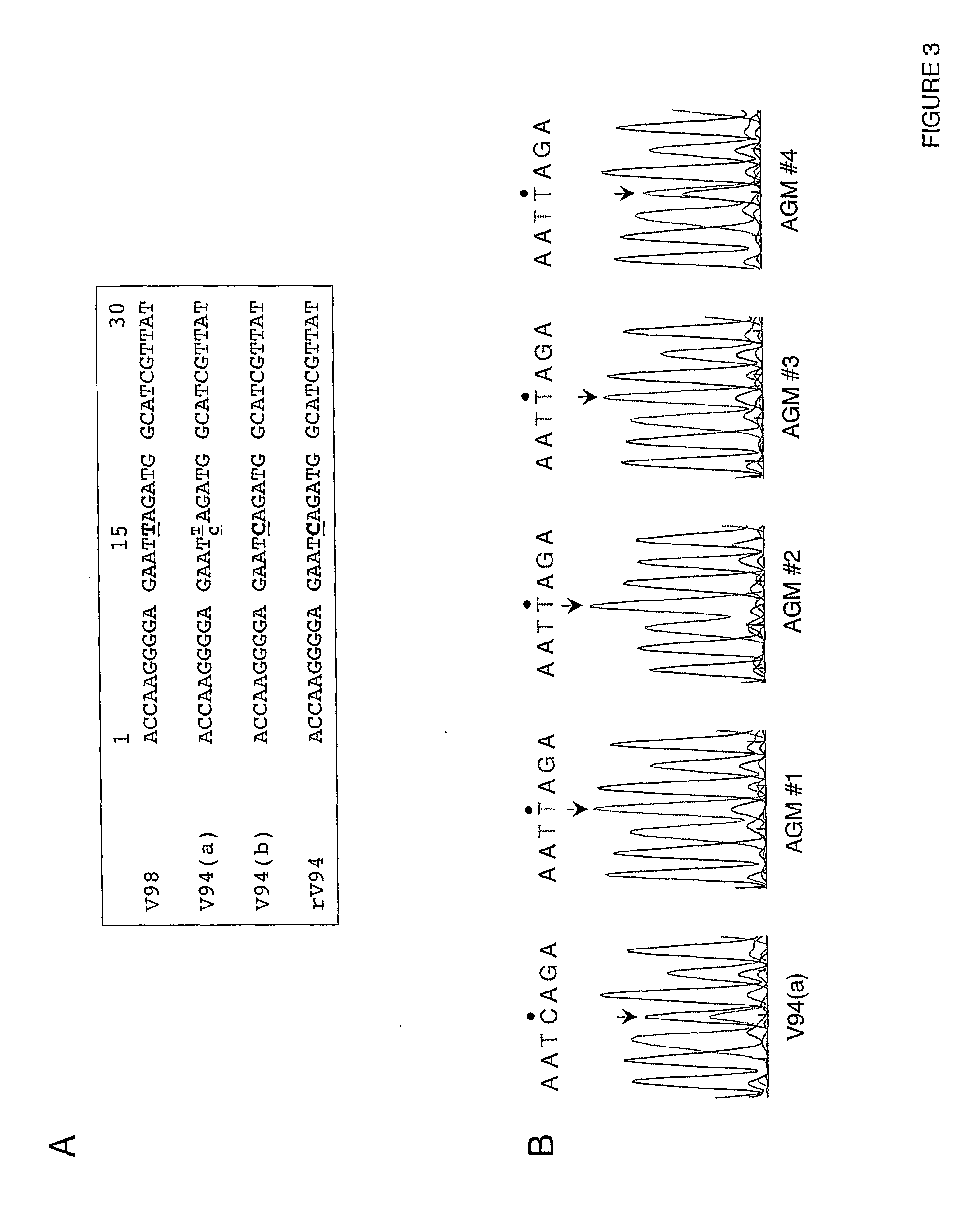Attenuated human parainfluenza virus, methods and uses thereof
a human parainfluenza virus and human parainfluenza virus technology, applied in the field of attenuated human parainfluenza virus, methods, can solve the problems of limiting the use of chimeric hpiv3 vaccines bearing heterologous, undesirable negative strand viruses as vectors, and no parainfluenza virus vaccines availabl
- Summary
- Abstract
- Description
- Claims
- Application Information
AI Technical Summary
Benefits of technology
Problems solved by technology
Method used
Image
Examples
example 1
Level of Attenuation and Stability Conferred by L Protein Mutations Enhanced by Alternative Codon Substitution
[0160]Attenuated HPIV1 and HPIV2 vaccine candidates were previously generated by amino acid substitutions at loci in the L protein (WO04 / 027037; (McAuliffe et al., 2004)). In this example, the level of attenuation conferred by alternative codon substitutions at mutant loci in the L protein was studied. Codon substitution mutations were designed so that at least two nucleotide changes would be required to regenerate a codon specifying the wild type amino acid at each position, thereby reducing the chance of spontaneous reversion to a codon specifying the wild type amino acid. For example, taking the commonly cited value of 10−4 for the mutation rate for a RNA virus, reversion that requires a single nucleotide substitution would occur at a frequency of ˜10−4 whereas reversion requiring two or three substitutions would occur at the greatly reduced frequencies of ˜10−8 and ˜10−1...
example 2
Identification of a Putative Non-ts, Host-Range att Mutation in the 3′ Leader Sequence of HPIV2 / V94
[0191]In African green monkeys, we noted a significant and unexpected difference between the level of replication of the rV94 bearing the pre-N ORF NotI restriction site (rV94Not) versus the biologically derived V94 in the lower respiratory tract (Table 5 and FIG. 2). With the exception of the introduced pre-N ORF NotI restriction site and a translationally silent nucleotide substitution in the F ORF, the recombinant V94 sequence was identical to that determined for the biologically derived virus (Skiadopoulos et al., 2003b). To establish whether the introduced NotI site was responsible for the attenuation phenotype, we compared the level of replication of biologically derived V94 to that of a recombinant V94 (rV94) that does not includes the pre-N ORF NotI site. We found that rV94 was also significantly attenuated in the lower respiratory tract of African green monkeys (FIG. 2 and Tab...
example 3
Recombinant HPIV2 Including Separate Polynucleotides Encoding P or V Protein
[0202]The bicistronic P / V gene of HPIV2 encodes the nucleocapsid-associated P phosphoprotein (395 amino acids) and the accessory V protein (225 amino acids) from two overlapping reading frames (Ohgimoto et al., 1990). Since the V protein is not absolutely required for virus replication (Kato et al., 1997; Fukuhara et al., 2002; He et al., 2002; Sun et al., 2004), it is an attractive target for the introduction of mutations that do not interfere with the replication of a vaccine virus in cell culture but attenuate the virus for replication in a human host. The overlapping nature of the P and V ORFs, however, greatly restricts the number and types of mutations that can be introduced into the V protein without also affecting the P protein (and vice versa). To overcome this obstacle we have undertaken a novel approach and modified the HPIV2 V94 strain antigenomic cDNA such that the P and V proteins are encoded b...
PUM
| Property | Measurement | Unit |
|---|---|---|
| Fraction | aaaaa | aaaaa |
| Volume | aaaaa | aaaaa |
| Volume | aaaaa | aaaaa |
Abstract
Description
Claims
Application Information
 Login to View More
Login to View More - R&D
- Intellectual Property
- Life Sciences
- Materials
- Tech Scout
- Unparalleled Data Quality
- Higher Quality Content
- 60% Fewer Hallucinations
Browse by: Latest US Patents, China's latest patents, Technical Efficacy Thesaurus, Application Domain, Technology Topic, Popular Technical Reports.
© 2025 PatSnap. All rights reserved.Legal|Privacy policy|Modern Slavery Act Transparency Statement|Sitemap|About US| Contact US: help@patsnap.com



